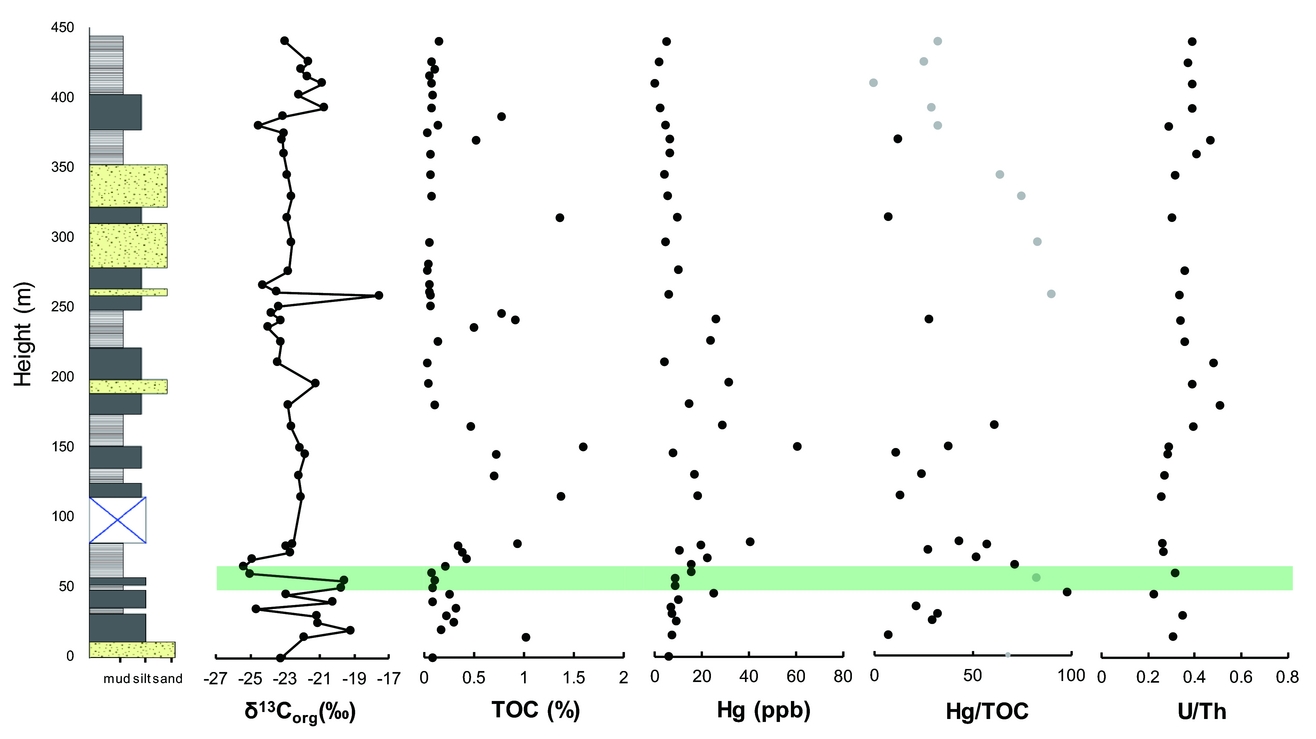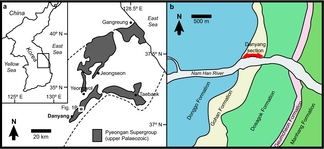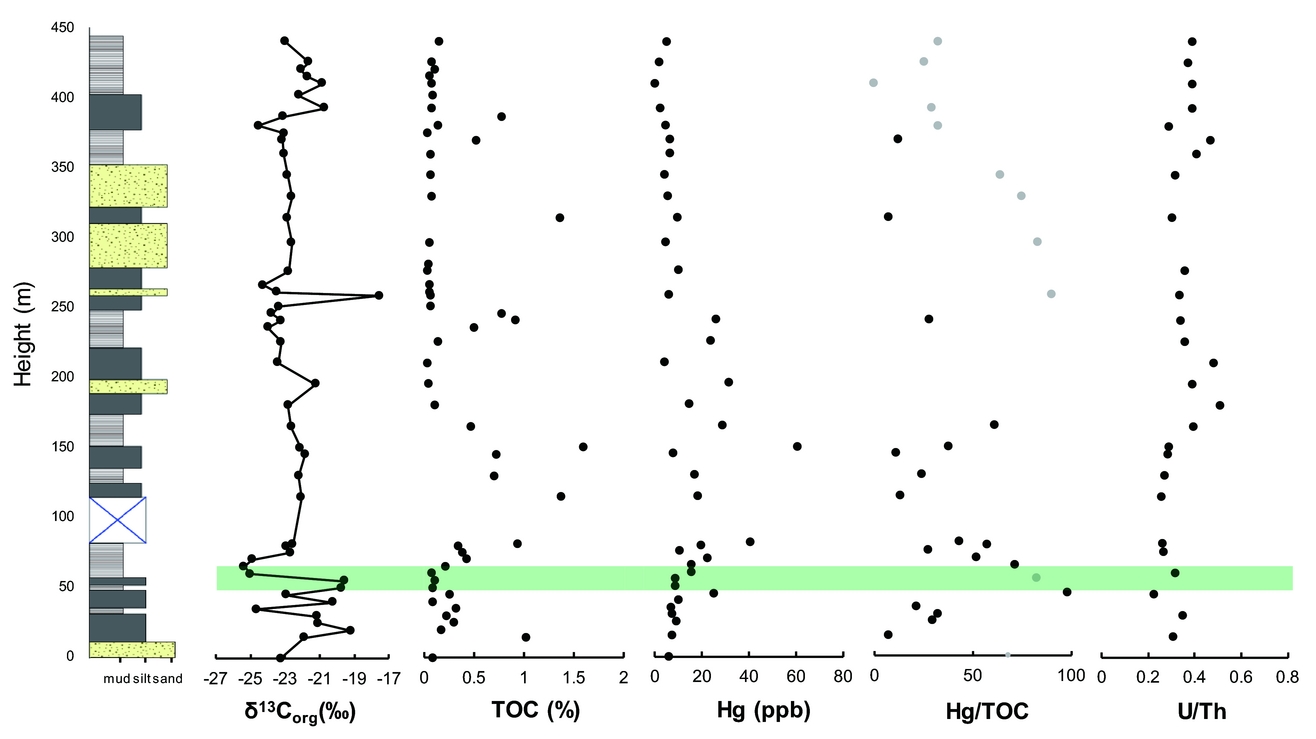1. Introduction
The Captanian mass extinction event had a major impact on the marine realm near the end of the middle Permian Period (Stanley & Yang, Reference Stanley and Yang1994; Bond et al. Reference Bond, Hilton, Wignall, Ali, Stevebs, Sun and Lai2010a). The timing of the mass extinction has been in dispute; it is considered to be either the middle Capitanian (Shen & Shi, Reference Shen and Shi2009; Bond et al. Reference Bond, Wignall, Wang, Izon, Jiang, Lai, Sun, Newton, Shao, Védrine and Cope2010b) or near the Capitanian–Wuchiapingian boundary (Kaiho et al. Reference Kaiho, Chen, Ohashi, Arinobu, Sawada and Cramer2005; Groves & Wang, Reference Groves and Wang2013; Day et al. Reference Day, Ramezani, Bowring, Sadler, Erwin, Abdala and Rubidge2015). This extinction event is generally characterized by a major negative carbon isotope excursion (Retallack et al. Reference Retallack, Metzger, Greaver, Jahren, Smith and Sheldon2006; Bond et al. Reference Bond, Hilton, Wignall, Ali, Stevebs, Sun and Lai2010a) and is known to have been associated with anoxia and acidification in the oceans; it was possibly caused by the volcanic eruptions that produced the Emeishan Traps in southwest China (Wignall et al. Reference Wignall, Sun, Bond, Izon, Newton, Védrine, Widdowson, Ali, Lai, Jiang, Cope and Bottrell2009; Bond et al. Reference Bond, Wignall, Joachimski, Sun, Savov, Grasby, Beauchamp and Blomeier2015).
In general, carbon isotopic compositions of terrestrial plants reflect carbon isotopes of CO2 dissolved in ocean, as carbon as CO2 is continuously exchanged between ocean and atmosphere. Extinction of many groups of marine organisms due to biotic crisis would have limited oceanic primary production, leading to less consumption of organic carbon and resulting in isotopically light dissolved CO2 in the ocean. Enrichment of organic carbon (relatively enriched in 12C) will result in a negative δ13C excursion in the ocean–atmosphere system. As plants use carbon dioxide in the atmosphere through photosynthesis, this would result in a negative δ13C excursion in plant matters in terrestrial environments. Many studies of continental organic matter have demonstrated that the atmospheric signal dominated over local factors such as taxonomic, environmental and diagenetic effects (Hasegawa, Reference Hasegawa1997; Gröcke, Hesselbo & Jenkyns, Reference Gröcke, Hesselbo and Jenkyns1999; Arens, Jahren & Amundson, Reference Arens, Jahren and Amundson2000; Hesselbo et al. Reference Hesselbo, Jenkyns, Duarte and Oliveira2007; Belcher et al. Reference Belcher, Mander, Rein, Jervis, Haworth, Hesselbo, Glasspool and McElwain2010; Nunn et al. Reference Nunn, Price, Gröcke, Baraboshkin, Leng and Hart2010; Dal Corso et al. Reference Dal Corso, Preto, Kustatscher, Mietto, Roghi and Jenkyns2011).
A temporal link between continental flood basalt volcanism and mass extinction is well established (Courtillot & Renne, Reference Courtillot and Renne2003; Wignall, Reference Wignall2005; Jourdan et al. Reference Jourdan, Hodges, Sell, Schaltegger, Winggate, Evins, Söderlund, Haines, Phillips and Blenkinsop2014; Bond & Grasby, Reference Bond and Grasby2017; Ernst & Youbi, Reference Ernst and Youbi2017), supporting the idea of a cause-and-effect relationship. This link between the Capitanian mass extinction event and eruption of Emeishan flood basalts has been demonstrated by Wignall et al. (Reference Wignall, Sun, Bond, Izon, Newton, Védrine, Widdowson, Ali, Lai, Jiang, Cope and Bottrell2009). Investigation of the global influence of Emeishan volcanism is important for understanding the relationship between the mass extinction and the development of this igneous province. Volcanism is known to be a major natural source of mercury (Hg), emitting it as a trace gas (Pyle & Mather, Reference Pyle and Mather2003). A typical atmospheric residence time of gaseous elemental Hg is 0.5–2 years (Blum, Sherman & Johnson, Reference Blum, Sherman and Johnson2014). Since Hg emitted from explosive volcanism is assumed to be transported long range in the atmosphere, it is globally distributed before being drawn down and eventually deposited in sediments. Sedimentary Hg is a proxy for volcanic volatiles, especially linked to large igneous provinces (LIPs), and has been reported in many recent studies (Sanei, Grasby & Beauchamp, Reference Sanei, Grasby and Beauchamp2012; Sial et al. Reference Sial, Lacerda, Ferreira, Frei, Marquillas, Barbosa, Gaucher, Windmöller and Pereira2013, Reference Sial, Chen, Lacerda, Peralta, Gaucher, Frei, Cirilli, Ferreira, Marquillas, Barbosa, Pereira and Belmino2014, Reference Sial, Chen, Lacerda, Frei, Tewari, Pandit, Gaucher, Ferreira, Cirilli, Peralta, Korte, Barbosa and Pereira2016; Grasby et al. Reference Grasby, Beauchamp, Bond, Wignall, Talavera, Galloway, Piepjohn, Reinhardt and Blomeier2015, Reference Grasby, Beauchamp, Bond and Wignall2016; Percival et al. Reference Percival, Witt, Mather, Hermoso, Jenkyns, Hesselbo, Al-Suwaidi, Storm, Xu and Ruhl2015, Reference Percival, Cohen, Davies, Dickson, Hesselbo, Jenkyns, Leng, Mather, Storm and Xu2016, Reference Percival, Ruhl, Hesselbo, Jenkyns and Mather2017; Font et al. Reference Font, Adatte, Sial, Drude de Lacerda, Keller and Punekar2016, Reference Font, Adatte, Andrade, Keller, Bitchong, Carvallo, Ferreira, Diogo and Mirão2018; Thibodeau & Bergquist, Reference Thibodeau and Bergquist2017). Grasby et al. (Reference Grasby, Beauchamp, Bond and Wignall2016) reported an Hg anomaly associated with Capitanian extinction from Spitsbergen, Norway (NW Pangea), and suggested that the Hg loading to the environment may have been a contributing cause to the mass extinction event. More reports on Hg anomaly may strengthen the cause-and-effect scenario by supporting the close temporal link between the onset of large volcanic eruptions and extinction.
Here, we studied the volatile emissions and ocean–atmosphere impacts of the eruption of the Emeishan LIP in SW China by analysis of sedimentary mercury concentrations and carbon isotopic composition of organic matter in an upper Permian (Capitanian–Wuchiapingian) terrestrial sedimentary succession in the Taebaeksan Basin, central eastern Korea. During Permian time the Korean Peninsula belonged to the Sino-Korean block (SKB; also called the North China block). The SKB and the South China block were separated blocks within the eastern Palaeo-Tethys Ocean before their amalgamation during Triassic time (Meng & Zhang, Reference Meng and Zhang1999). The Taebaeksan Basin in the eastern SKB was situated at low palaeolatitudes (c. 6°N; Doh & Piper, Reference Doh and Piper1994). This study reports a record in the SKB that there was a potential environmental impact due to volatile emissions from the Emeishan LIP and demonstrates that the Hg cycle was indeed perturbed on a global scale during the Capitanian extinction.
2. Geological setting
In South Korea, upper Palaeozoic sediments (the Pyeongan Supergroup) are distributed in several coalfields in the Taebaeksan Basin (Fig. 1). The detritus for the Pyeongan Supergroup was mostly derived from recycled orogens located to the east and SE of the Korean Peninsula (Yu, Lee & Boggs, Reference Yu, Lee and Boggs1997; Lee & Sheen, Reference Lee and Sheen1998; Kim, Lee & Choi, Reference Kim, Lee and Choi2017). The Gohan Formation in this study is from the Danyang coalfield (Fig. 1). The Gohan Formation in this coalfield consists dominantly of black to dark-grey shale with medium-bedded dark-grey coarse sandstone and light-green medium sandstone. The thickness of the Gohan Formation in this coalfield reaches 450 m.

Figure 1. (a) The grey areas represent the coalfields with distribution areas of the Pyeongan Supergroup in central eastern Korea. The dotted lines represent the boundaries of the Taebaeksan Basin. (b) Geological map (after Park et al. Reference Park, Shin, Jeong, Lee, Yoon, Kim and Hwang1975) showing the location of the Danyang section in the Danyang coalfield (white boxed area in (a)). The stratigraphic top is to the NW.
As the middle–upper Permian deposits of the SKB are represented by terrestrial sequences, regional correlation and age determination have been largely dependent on the fossil plant biostratigraphy despite its limitations. Chun (Reference Chun1985, Reference Chun1987) identified fossil plants such as Lobatannularia heianensis, Sphenophyllum sp. cf. kawasaki, Gigantopteris nicotianefolia, Alethopteris huiana, Compsopteris contracta, C. wongii, Cladophlebis sp., Taeniopteris multinervis, Chiropteris reniformis, Cordaites principalis, Pterophyllum diahoensis and Pt. sp. cf. nilssonioides in the Gohan Formation, and established the G. nicotianaefolia–Ch. reniformis–L. heianensis Assemblage. Detailed investigation on the underlying stratigraphic unit, the Dosagok Formation, revealed that the base of this assemblage lies in the middle–upper part of the Dosagok Formation (S. Y. Kim, unpub. M.Sc. thesis, Seoul National University, 1985). Characterized by the occurrence of the Gigantopteris and several others including L. heianensis, its floral composition is largely similar to some known assemblages in North China which have been generally attributed to the Capitanian–Wuchiapingian (refer to Wang, Reference Wang2010 for summary on the upper Palaeozoic fossil plant assemblages in North China). These assemblages also share the feature that they follow the demise of older plant species such as Emplectopteris triangularis. At the section near Taiyuan, Shanxi Province, Stevens et al. (Reference Stevens, Hilton, Bond, Glasspool and Jardine2011) correlated the horizon of a similar floral change to the Roadian (Lower Shihhotse Formation or LSF extinction); such age correlation deviates widely from other studies conducted in North China however, probably due to an inaccurate assignment of the Illawara geomagnetic reversal horizon in their section. In the Taebaeksan Basin, it has been reported that the Dosagok Formation records both the normal and reversed geomagnetic polarities (Doh, Reference Doh1995), and therefore the stratigraphic horizon of the Illawara reversal should be placed either within or below the Dosagok Formation. The information from both biostratigraphy and palaeomagnetism suggests that the Dosagok Formation has a Wordian–Capitanian depositional age. The exact depositional ages of the base and top of the Gohan Formation remain speculative. However, given that only the reversed geomagnetic polarity was reported from randomly collected samples of the Gohan Formation (Doh, Reference Doh1995), the depositional age for much of this formation is likely to correspond to the Wuchiapingian Age, the time interval dominated by reversed polarity (Hounslow & Balabanov, Reference Hounslow, Balabanov, Lucas and Chen2016; Lucas & Shen, Reference Lucas, Shen, Lucas and Chen2017). The mean youngest age of detrital zircons from the Gohan Formation sandstone is 261±2.5 Ma (Lee, Choi & Orihashi, Reference Lee, Choi and Orihashi2012), which further supports this interpretation. While the lower part of the Gohan Formation may correspond to the timing of the Capitanian extinction and/or the Emeishan volcanism, direct evidence of extinction has not been reported from this formation.
3. Methods
A total of 143 samples were collected with a sampling interval of 2.5 m at the Danyang section (Fig. 1b). Total organic carbon (TOC) content was analysed using a carbon-nitrogen (CN) elemental analyser (FlashEA 1112), and carbon isotopic values of organic matter (δ13Corg) were analysed by a stable isotope ratio mass spectrometer (IsoPrime-EA, Micromass, UK) interfaced with an elemental analyser at the National Instrumentation Center for Environmental Management, Seoul National University. Carbon isotopic values were presented in parts per thousand (‰) deviation from the Peedee Belemnite (PDB). The analytical precision based on repeated measurements of the laboratory standard was better than ±0.1‰ (i.e. Hong & Lee, Reference Hong and Lee2013). Mercury concentration was analysed by a Milestone DMA-80 direct mercury analyser following standard methods (American Society for Testing and Materials, 2006) at Chungnam National University. Each sample was measured three times and the results were averaged. Trace element composition was analysed by a VG elemental PQII and an inductively coupled plasma mass spectrometer at the Korea Basic Science Institute.
4. Results and discussion
The average background Hg value is 6 ppb. Hg values in the basal 40 m are 6–9 ppb and then show a shift at 45 m to a value of 25 ppb, followed by a subsequent decline to 8 ppb at 50–55 m. In the section interval from 60 m to 239 m level, Hg concentrations show an order of magnitude higher than the background value. In the remaining upper part of the section the Hg concentration is low, less than 10 ppb with an average of 5 ppb. The Hg concentrations are plotted in Figure 2.

Figure 2. Plots of geochemical data from the Danyang section showing carbon isotope values for organic carbon, Hg values, Hg (ppb) normalized by TOC (%) (the Hg/TOC values are shown in black for values of TOC >0.2% and grey for TOC values <0.2%), percent total organic carbon (TOC) and U/Th ratios (ratios from sandstones are excluded). The horizontal bar represents the level of the interpreted Capitanian mass extinction event.
As sedimentary drawdown of Hg is typically achieved via organic matter (Benoit et al. Reference Benoit, Mason, Gilmour and Aiken2001; Outridge et al. Reference Outridge, Sanei, Stern, Hamilton and Goodarzi2007), sedimentary Hg concentrations are normalized against TOC to account for the effect on Hg drawdown by changes in organic matter deposition rates (Sanei, Grasby & Beauchamp, Reference Sanei, Grasby and Beauchamp2012). TOC content is generally less than 0.3%, with some values reaching 1.6%. Given the low organic matter content throughout much of the Danyang section, reliable Hg/TOC ratios are not always possible to obtain. For values of < 0.2% TOC, inaccuracies in measurement can lead to magnified errors and highly variable Hg/TOC values that are not reflective of natural conditions (cf. Grasby et al. Reference Grasby, Beauchamp, Bond and Wignall2016). These data were marked in grey for consideration when interpreting Figure 2. For TOC values of > 0.2%, broad spikes in both Hg concentrations as well as Hg/TOC values are noted in the 45–81 m section interval.
The δ13Corg data from the Danyang section show initially relatively fluctuating values between –23.3‰ and –19.2‰ from the base to c. 60 m, at which a pronounced negative shift (5.8‰) occurs. The carbon/nitrogen (C/N) ratio of organic matter is less than 10, suggestive of lacustrine algae during the δ13Corg negative excursion. However, given the low TOC content (< 0.5%) in most samples, including the negative carbon excursion level, the possibility of artificially depressed C/N ratios cannot be excluded considering that the proportion of inorganic nitrogen can be relatively high in the residual nitrogen (Meyers & Teranes, Reference Meyers, Teranes, Last and Smol2001). Such a large negative carbon isotope excursion implies a major perturbation to the carbon cycle. After this point there is a progressive recovery through the next 10 m before the covered interval to –23‰, the general background value. A weak positive excursion (–21.2‰) occurs at the 194 m level, followed by a strong positive excursion to –17.6‰ at 256 m. At the top of the Danyang section two weak positive peaks (–20.7‰ and –20.8‰) are noted.
As clay minerals are the alternative host for scavenging Hg in sediment via adsorption and subsequent deposition (Kongchum, Hudnall & Delaune, Reference Kongchum, Hudnall and Delaune2011), we also analysed Al2O3 content of the studied samples. Correlation between Al2O3 content and Hg concentration (R = –0.08, p = 0.66) is lacking, indicating that Hg fluctuations are not controlled primarily by clay content. Because Hg is sensitive to anoxia and heating, it may undergo transformations and possible migration, resulting in losses of Hg (Bergquist, Reference Bergquist2017). However, the measured redox-sensitive elemental ratios (U/Th) are less than 0.6 in the Danyang section, which suggests that the water column in the depositional environment was under oxygenated conditions (cf. Jones & Manning, Reference Jones and Manning1994) and the elevated Hg/TOC spike level does not show changes in redox state, suggestive of the elevated Hg/TOC ratios resulting from Hg input. The facies changes that might have affected the Hg shift were not observed in thin-sections (online Supplementary Fig. S1, available at http://journals.cambridge.org/geo).
In the lower part of the Danyang section an abrupt increase in Hg concentrations and Hg/TOC ratios are correlated with the negative excursion in δ13Corg. As the Capitanian extinction event is characterized by the globally observed δ13C negative excursion (Bond et al. Reference Bond, Wignall, Joachimski, Sun, Savov, Grasby, Beauchamp and Blomeier2015; Grasby et al. Reference Grasby, Beauchamp, Bond, Wignall, Talavera, Galloway, Piepjohn, Reinhardt and Blomeier2015), occurring coevally with Hg anomaly (Grasby et al. Reference Grasby, Beauchamp, Bond and Wignall2016), the correlation between Hg/TOC excursion and negative δ13Corg excursion is tentatively suggestive of a perturbation to the global Hg and carbon cycles at the extinction event. While it is difficult to provide a comprehensive age model, this correlation allows the Hg/TOC increase to be stratigraphically matched to the Emeishan LIP volcanism. Accordingly, the stratigraphic level showing both the negative excursion in δ13Corg and Hg/TOC spikes may mark the Capitanian extinction event recorded in the Gohan Formation.
5. Conclusions
A prominent negative δ13Corg excursion occurs in the lower Gohan Formation in Danyang, central eastern Korea. A mercury anomaly is also observed in the lower part of the Danyang section. The mercury anomaly occurs at the same level with a prominent negative δ13Corg excursion. The coincidence of timing between the negative δ13Corg excursion and mercury anomaly strongly suggests that this level may represent the record of the Capitanian mass extinction event in the Gohan Formation. This case study from the SKB, separated from the South China block with the Emeishan LIP, demonstrates that the Hg cycle was globally perturbed in association with the global carbon cycle perturbation that occurred during the Capitanian mass extinction.
Acknowledgements
This work was supported by the National Research Foundation of Korea (grant no. 2014R1A2A2A01005404). We thank the journal editor, Professor S.M. Hubbard, and two anonymous journal reviewers for their constructive comments which led to the improvement of our manuscript.
Supplementary material
To view supplementary material for this article, please visit https://doi.org/10.1017/S0016756818000481




